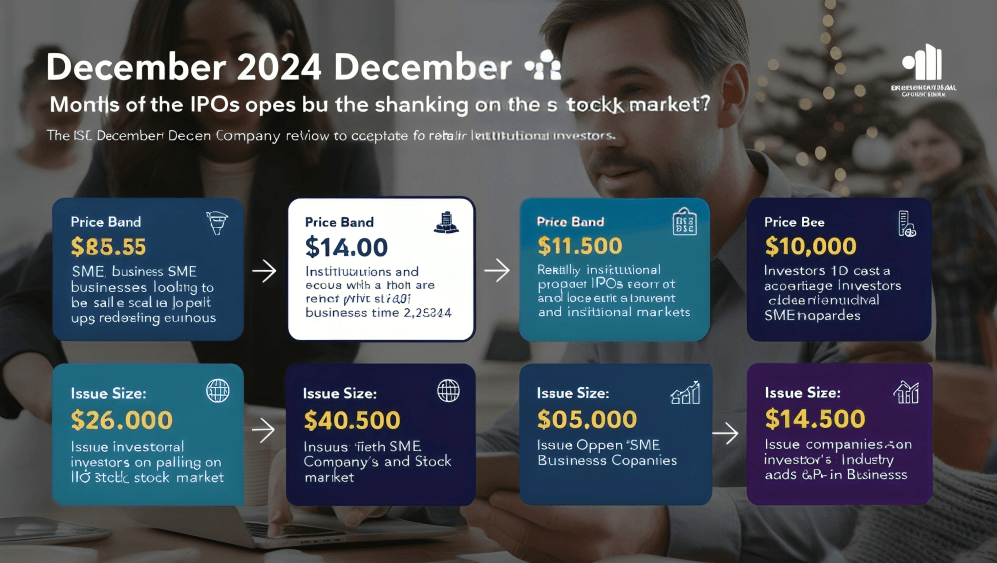Understanding the Evolution of IPOs and Direct Listings
Direct Listings vs IPOs has become a key debate in 2024, as investors and companies evaluate the benefits and risks of these public offering methods. With Direct Listings gaining popularity for their transparency and cost savings, understanding the Benefits of Direct Listings is essential for smart investing decisions. This article dives deep into these trends and what they mean for the future of going public.
Table of Contents
- Introduction: Understanding the Evolution of IPOs and Direct Listings
- What is a Direct Listing? How Does It Differ from Traditional IPOs?
- Understanding Direct Listings
- Traditional IPOs: The Long-Standing Route
- Key Differences Between Direct Listings and IPOs
- The Growing Popularity of Direct Listings in 2024
- Why Companies Are Choosing Direct Listings
- High-Profile Direct Listings in 2024
- Benefits of Direct Listings for Companies and Investors
- Lower Costs and Greater Control
- Enhanced Liquidity and Transparency
- Investor Access to Market-Driven Prices
- Risks and Challenges Associated with Direct Listings
- Lack of Underwriter Support and Market Guidance
- Limited Initial Price Discovery
- Investor Perception and Market Confidence
- The Future of Direct Listings: Will They Replace Traditional IPOs?
- Market Sentiment and Industry Shifts
- Regulatory Changes and the Role of the SEC
- The Hybrid Model: Direct Listings and IPOs Combined?
- Frequently Asked Questions (FAQs)
- Conclusion: Is a Direct Listing Right for Your Investment Portfolio?
Introduction: Understanding the Evolution of IPOs and Direct Listings
In recent years, the way companies go public has shifted, with a growing interest in direct listings as an alternative to the traditional Initial Public Offering (IPO). Traditionally, companies looking to raise capital through public markets would go down the IPO route, a process that involves hiring underwriters, setting an initial price range for shares, and gradually building investor demand. However, direct listings have emerged as a disruptive option, allowing companies to bypass underwriters and set their pricing based on market demand, offering more control and transparency to both the companies and investors.
The direct listing model has seen a surge in popularity, particularly among high-profile tech companies like Spotify, Slack, and Roblox. These companies have paved the way for others to follow suit, demonstrating that direct listings can offer distinct advantages over traditional IPOs, such as lower costs, greater control, and enhanced liquidity. However, with these benefits come risks, including price volatility and market uncertainty, which have made direct listings a topic of debate within the financial world.
As we look toward 2024, direct listings are being considered as a legitimate alternative to traditional IPOs, especially as the financial market continues to evolve and new companies seek innovative ways to access capital. In this article, we’ll explore the key differences between direct listings and IPOs, the benefits and risks associated with direct listings, and how the future of IPOs might be shaped by this rising trend.
Table of Contents
ToggleDirect Listings vs IPOs in 2024: The Rise, Benefits, and Risks
In 2024, the debate between Direct Listings vs IPOs has gained momentum as more companies seek innovative ways to go public. The traditional Initial Public Offering (IPO) process has been the go-to method for companies to raise capital and expand their investor base for decades. However, direct listings have increasingly emerged as a compelling alternative, driven by their potential to reduce costs and offer greater control to the companies themselves. This shift marks a significant change in how companies approach their public debut, especially in industries like technology, where speed and flexibility are crucial.
A direct listing allows companies to bypass the traditional IPO process, avoiding underwriters and the associated costs. Instead of setting an offering price and engaging in a roadshow to generate demand, the company’s shares are made available for trading directly on the stock exchange, with the price determined by market forces. This model has been adopted by several high-profile companies, such as Spotify, Slack, and Roblox, all of which demonstrated that direct listings could be a viable, even advantageous, route for firms looking to go public.
Direct Listings vs IPOs: The most striking difference between the two methods lies in their structure. In an IPO, underwriters play a key role in pricing the shares and allocating them to institutional investors. They also help generate demand through marketing campaigns. While this provides a level of stability and security for both the company and its investors, it comes at a cost, typically 7-8% of the total capital raised. By contrast, direct listings eliminate the need for underwriters, significantly reducing fees and costs associated with going public. This can be especially appealing to companies that already have established customer bases or brand recognition, like Spotify and Slack, where there’s already considerable investor interest.
Benefits of Direct Listings
The primary appeal of direct listings lies in the lower costs and greater control they offer. Companies can avoid the hefty fees associated with underwriters and the lengthy process involved in an IPO. This is particularly attractive for companies that do not require large amounts of capital upfront, such as mature tech firms with solid revenue streams. Direct listings also provide greater transparency, as pricing is determined by supply and demand rather than an artificially set price range. This creates a more accurate market value for the shares, which benefits both the company and the investors.
One of the major benefits of direct listings is liquidity. With direct listings, shares are immediately available for public trading, allowing investors to buy and sell shares without the typical lock-up periods that restrict trading in the early months following an IPO. This increased liquidity is particularly advantageous for early investors, employees, and stakeholders who might want to cash out after the public debut. Furthermore, direct listings are considered more efficient because they eliminate the need for marketing efforts that typically accompany an IPO. Companies can go public without spending extensive resources on roadshows or media campaigns, allowing them to focus on business operations.
Risks of Direct Listings
However, direct listings are not without their challenges. One of the risks of direct listings is the potential for volatility. Without underwriters to manage the price-setting process, the initial trading day can be unpredictable. The lack of price stabilization mechanisms could lead to a price drop or instability, especially in cases where investor interest is high or low. This makes direct listings a less stable option compared to IPOs, where underwriters work to control price fluctuations and create a smoother market debut.
Another risk for companies opting for direct listings is the lack of investor guidance In a traditional IPO, underwriters provide institutional investors with insights and recommendations, helping them make informed decisions. In a direct listing, investors must rely solely on the market to set the share price, which can be intimidating for those unfamiliar with this approach. The absence of an organized pricing mechanism can result in fewer institutional buyers participating, as some investors may view direct listings as a more speculative endeavor.
Lastly, direct listings might not be suitable for every company. For smaller companies or those without a significant brand presence, the lack of a roadshow or underwriter support may lead to reduced investor interest and underwhelming demand. Without the marketing power of an IPO, these companies may struggle to attract enough investor attention, impacting their long-term success on the stock exchange.
Conclusion
The shift from IPOs to direct listings marks a significant evolution in the public offering process, providing both benefits and risks for companies and investors alike. While direct listings offer lower costs, greater control, and immediate liquidity, they also present challenges such as price volatility and a lack of market stabilization. As more companies explore direct listings in 2024, it’s clear that this method of going public will continue to evolve, offering a promising but complex alternative to traditional IPOs. The decision of whether to pursue a direct listing or IPO ultimately depends on the company’s size, goals, and risk tolerance, as well as the broader market conditions at the time of the listing.
Introduction: Understanding the Evolution of IPOs and Direct Listings
Over the last few decades, the landscape of public offerings has undergone significant changes, driven by evolving market dynamics, investor demands, and the advent of new financial technologies. Traditionally, companies seeking to go public would undergo a process called an Initial Public Offering (IPO), a model that has been the standard route for decades. In recent years, however, an alternative method known as direct listings has gained traction, offering a new approach for companies to raise capital and access the public markets. As of 2024, direct listings are being viewed as a revolutionary development in the IPO space, changing how both companies and investors approach public offerings.
Direct Listings vs IPOs: Key Differences
- To understand the rise of direct listings in 2024, it’s essential to first examine how this method contrasts with traditional IPOs. An IPO is a more structured process where a company works with underwriters, usually large investment banks, to sell shares to the public for the first time. These underwriters help set the offering price, generate demand through a book-building process, and offer advice on how to manage the stock’s debut in the market. The IPO process typically involves extensive due diligence, marketing, and a set price range to ensure investor interest, often leading to high upfront costs.
- In contrast, a direct listing skips the middleman no underwriters are involved, and no new shares are created. Instead, the company’s existing shareholders, including employees and investors, are allowed to sell their shares directly to the public. Since there’s no price range or underwriters to influence the market, the price is determined purely by supply and demand on the exchange. This results in a more transparent and flexible pricing structure. While this method is less costly than traditional IPOs, it requires companies to have an established brand and substantial investor interest to ensure the stock is adequately priced.
The Growing Popularity of Direct Listings in 2024
- As we move further into 2024, direct listings have increasingly become an attractive option for companies, especially those in tech and high-growth sectors. Companies like Spotify, Slack, and Roblox have already pioneered the trend, demonstrating that direct listings can provide significant cost savings and greater control over their public debut. In these cases, the direct listing allowed these companies to bypass hefty underwriting fees and instead focus on creating a market-driven price for their shares.
- In particular, the cost-effectiveness of direct listings is appealing for startups and growing companies that might not want to bear the financial burden of an IPO. Moreover, direct listings offer greater flexibility in timing—companies can choose to list their shares when they feel the time is right, without being bound to the schedules and restrictions that often accompany traditional IPOs. This flexibility is especially appealing in a rapidly changing market environment where market volatility can affect IPO pricing and success.
- The direct listing model also appeals to investors, as it offers a transparent market mechanism for pricing shares. Unlike IPOs, where underwriters may influence pricing decisions, direct listings allow investors to trade shares at market-driven prices. This can lead to more equitable pricing for both retail and institutional investors, making it an attractive method of going public for both growth companies and investors seeking opportunities.
- Challenges and Considerations for Companies Choosing Direct Listings in 2024
- Despite its advantages, direct listings are not without challenges. While companies can save on underwriting fees and avoid the need for traditional book-building, the process is more risky for companies without established brand recognition. The absence of underwriters means there’s no safety net for price stability on the first day of trading. Without an initial price set by underwriters, the market may see a sharp price fluctuation, which could scare off potential investors.
- Another consideration is that direct listings may be more suitable for companies with strong financials, solid backing, and an established market presence. For smaller companies or those lacking significant consumer recognition, the risks of a direct listing might outweigh the potential benefits, as these companies may struggle to attract the investor demand necessary to ensure a successful listing.
Conclusion: The Future of Direct Listings in 2024
- As direct listings continue to evolve, they represent a critical shift in how companies approach going public. In 2024, these offerings are expected to gain more popularity, particularly in industries where companies have established significant market value, like technology, fintech, and consumer goods. As investors grow more comfortable with the process, and as regulatory frameworks around direct listings evolve, more companies will likely consider this method in the future.
- The direct listing vs IPO debate will continue, with some companies opting for the traditional route to ensure maximum investor interest and a smoother market entry, while others, especially those looking to retain greater control and reduce costs, may increasingly choose direct listings as the preferred method of the public offering. By understanding these shifts and their potential impact, both companies and investors can better navigate the ever-changing landscape of public markets in 2024 and beyond.
What is a Direct Listing? How Does It Differ from Traditional IPOs?
In recent years, direct listings have gained significant attention as a potential alternative to traditional Initial Public Offerings (IPOs). While both routes allow companies to go public and raise capital, the mechanics and advantages differ considerably. Understanding these differences can provide valuable insights for investors and companies considering their options in today’s dynamic financial markets. In this section, we will explore the nature of direct listings, their differences from traditional IPOs, and how they function in practice.
Understanding Direct Listings
What is a Direct Listing?
A direct listing is a method for a company to become publicly traded without going through the traditional IPO process. Unlike an IPO, where shares are priced and sold by underwriters to institutional and retail investors, a direct listing allows existing shares to be listed on an exchange and made available for public trading directly. This process eliminates the need for an initial price offering and underwriters, resulting in lower fees and greater flexibility.
In a direct listing, a company does not issue new shares but instead lists its existing shares on a public exchange like the New York Stock Exchange (NYSE) or NASDAQ. Underwriters, who play a key role in determining the pricing and ensuring the success of IPOs, are not involved in the process. Instead, the price of the shares is determined through market demand, meaning that the market itself plays a crucial role in setting the opening price based on the supply and demand for those shares.
The absence of an initial public offering price range is one of the defining characteristics of a direct listing. In an IPO, the underwriters work to establish an offering price based on market research, negotiations, and investor demand. However, in a direct listing, the opening price is determined solely by the buyers and sellers in the open market on the first day of trading. This gives companies more control over the listing process, bypassing the pricing volatility that is often associated with IPOs.
Traditional IPOs: The Long-Standing Route
Traditional Initial Public Offerings (IPOs) have been the go-to method for companies looking to go public for decades. The IPO process involves several steps and requires a company to work with underwriters to manage the offering, set the price range, and gauge market demand for the stock. Here’s a breakdown of the steps involved in a traditional IPO:
- Choosing Underwriters:
In an IPO, the company hires one or more investment banks, known as underwriters, who play a crucial role in the process. The underwriters are responsible for helping to set the price range for the shares, marketing the IPO to institutional and retail investors, and providing guidance on the timing of the listing. - Price Setting:
Underwriters determine the price range for the shares based on market demand and an in-depth analysis of the company’s financial health, growth prospects, and comparable market valuations. This process typically involves a roadshow, where the company and its underwriters meet with potential investors to gauge interest in the stock. - Issuing New Shares:
In contrast to a direct listing, an IPO typically involves the issuance of new shares. These new shares are sold to investors through the underwriting banks, with the proceeds going to the company. The underwriters also help to stabilize the stock price in the early days of trading, ensuring that the market demand aligns with the set pricing. - Market Debut:
Once the shares are priced and allocated, they begin trading publicly. The company is now officially listed on an exchange, and the underwriters continue to provide support, ensuring that there is a balance between supply and demand for the stock.
Traditional IPOs are considered a more structured route for going public, and they offer the benefits of professional market support and pricing stability. However, this comes at a cost. The underwriters typically charge a fee of 4-7% of the total capital raised, which can be a significant expense for companies. Furthermore, the process is often time-consuming and requires companies to disclose a great deal of sensitive financial and operational information, which may not be desirable for all companies.
Key Differences Between Direct Listings and IPOs
While both direct listings and IPOs aim to help companies go public, they differ significantly across several key areas. The most notable differences include pricing, fees, and the timing of the listing. Below is a comparison of these factors:
- Pricing:
- In a traditional IPO, the price of the shares is set by underwriters, based on their research and market demand. This ensures that the company’s shares are offered at a price that is acceptable to both the company and investors. However, it also means that companies have limited control over the final price at which their shares are sold.
- In contrast, a direct listing has no set price range. The price is determined entirely by the market demand for the existing shares once they hit the exchange. This flexibility allows companies to avoid underwriter fees and to see more accurate, real-time pricing based on investor sentiment.
- Fees:
- IPOs come with significant fees, usually ranging between 4% to 7% of the total capital raised. These fees are paid to underwriters for their services, including market research, pricing, and investor outreach. These costs can be substantial, especially for companies raising large sums of capital.
- With a direct listing, there are no underwriter fees, making it a more cost-effective alternative. However, companies may still need to pay for other services, such as legal and financial advisory fees.
- Timing and Flexibility:
- The IPO process is time-consuming and can take several months to complete, as the company must go through the regulatory approval process with the Securities and Exchange Commission (SEC), finalize the offering price, and conduct a roadshow.
- In contrast, a direct listing is typically much faster, as there is no need for the roadshow or price-setting process. Companies can choose to list their shares at a time that suits them best, based on market conditions.
- Market Support:
- One of the significant advantages of IPOs is that underwriters provide a degree of market support by guaranteeing the price range and stabilizing the stock post-launch. This ensures that the stock doesn’t experience extreme volatility in the early days of trading.
- On the other hand, direct listings come with less market support. Since there are no underwriters involved, the market will determine the price of the stock, which can lead to greater volatility in the initial trading days.
In conclusion, while direct listings provide companies with greater control, lower fees, and faster market access, traditional IPOs offer more pricing stability and market support, making them a safer choice for some companies. Understanding the key differences between these two approaches is crucial for companies considering going public, as well as for investors looking to make informed decisions about their investments.
The Growing Popularity of Direct Listings in 2024
The financial landscape in 2024 is seeing a shift in how companies go public, with an increasing number opting for direct listings instead of traditional Initial Public Offerings (IPOs). This growing preference is not just a passing trend but reflects broader changes in market dynamics, investor behavior, and corporate goals. Direct listings in 2024 are now seen as a viable alternative to IPOs, offering numerous advantages for both companies and investors.
One key reason for the rise in direct listings is the cost advantages. The traditional IPO process often involves hefty fees for investment bankers, underwriters, legal services, and other intermediaries, which can eat into the capital a company raises. In contrast, direct listings bypass underwriters, saving substantial costs while offering greater transparency. Companies like Spotify, Slack, and Roblox have demonstrated that direct listings can be a more efficient, cost-effective way to go public.
Another driving factor is the flexibility offered by direct listings. In an IPO, the timing and pricing of the offering are managed by underwriters, creating a level of uncertainty for companies. With direct listings, however, companies have greater control over the listing process, allowing them to time the market more precisely and adjust pricing based on real-time demand. This is especially attractive for tech companies that have high growth potential but want to avoid the scrutiny and restrictions associated with traditional IPOs.
Additionally, there is a growing demand for transparency in the financial markets. Traditional IPOs can often be opaque, with companies and investors relying on underwriters to determine share prices. In contrast, direct listings offer a more market-driven approach, where companies go public by selling shares directly to investors without a predetermined offering price. This method provides greater clarity for investors and allows for more efficient price discovery, which can result in a fairer valuation.
Why Companies Are Choosing Direct Listings
- The decision to opt for a direct listing rather than an IPO is motivated by several compelling reasons, which are particularly relevant in 2024’s market environment.
- Lower Costs: One of the most significant advantages of direct listings is the reduction in costs. In a traditional IPO, companies often pay a substantial amount in fees to investment banks and underwriters. According to some estimates, these fees can account for 7% or more of the total capital raised. By eliminating the need for underwriters, direct listings allow companies to save on these high fees, ultimately enabling them to keep more of the capital they raise. This is a crucial consideration for emerging growth companies that need to conserve capital for reinvestment into their business.
- Greater Control and Flexibility: Direct listings give companies more control over their public debut. In an IPO, underwriters typically determine the price range for shares, and the company has little say in the final pricing. In contrast, with direct listings, companies can decide when to list their shares, providing greater flexibility in timing. This flexibility allows them to avoid market volatility by choosing a more favorable period for their listing, maximizing the value of their offering.
- Transparency and Market-Driven Pricing: Another advantage of direct listings is the transparency they provide. Traditional IPOs often involve price setting by underwriters, which can be opaque and lead to pricing inefficiencies. Direct listings, on the other hand, use a market-driven approach, where the initial share price is determined by real-time supply and demand, providing investors with a more accurate price. This greater price discovery is appealing to investors who want a more transparent market entry.
- Enhanced Liquidity: Since direct listings allow for shares to be traded immediately after the listing, they provide enhanced liquidity compared to traditional IPOs. This means that investors can buy and sell shares without having to wait for the lock-up period to expire, making direct listings an attractive option for those who prioritize liquidity in their investment strategy.
High-Profile Direct Listings in 2024
- In 2024, several high-profile companies have turned to direct listings as an alternative to IPOs, proving that this method can be highly successful for large, well-established firms.
- Spotify made headlines in 2018 as one of the first major companies to go public via a direct listing. Since then, the company’s success has paved the way for other tech giants to follow suit. Spotify’s direct listing was viewed as a pioneering move, demonstrating the advantages of bypassing the traditional IPO process. By avoiding underwriters and pricing uncertainty, Spotify was able to maintain control over its offering, allowing the market to set the price for its shares based on demand. This move was particularly successful, as the company saw its stock price increase post-listing, showing that direct listings could generate strong market interest without the traditional risks of an IPO.
- Slack, the workplace messaging platform, followed Spotify’s lead in 2019 with its own direct listing. Slack’s direct listing allowed the company to go public without the traditional underwriting process, which helped it save on hefty fees. The direct listing model provided Slack with more flexibility in pricing and timing, which was crucial given the high volatility in the tech market at the time. Like Spotify, Slack’s direct listing was well-received by investors, and the company experienced positive trading activity following its public debut.
- Another example is Roblox, the online gaming company, which also chose a direct listing in 2021. Roblox’s decision to skip the IPO process was driven by similar motivations—primarily to reduce costs, maintain greater control over the listing, and allow for more flexibility in timing. Roblox’s direct listing proved successful, with the company’s stock price performing well in the market. The success of these high-profile companies has cemented direct listings as a viable option for tech companies looking to go public while minimizing costs and maximizing control.
- In 2024, direct listings continue to gain traction among companies across various industries, not just tech. With successful examples like Spotify, Slack, and Roblox, it’s clear that direct listings in 2024 are becoming a mainstream IPO alternative. As the demand for transparency, cost efficiency, and flexibility grows, more companies are likely to follow suit, making direct listings a key trend to watch in the public offering space.
Benefits of Direct Listings for Companies and Investors
Direct listings have emerged as a groundbreaking alternative to traditional IPOs, offering unique advantages for both companies and investors. Unlike the lengthy and expensive process of a traditional IPO, direct listings simplify public market entry, giving companies greater autonomy while allowing investors to participate in an environment driven by real market dynamics. Let’s explore the benefits of direct listings in detail.
Lower Costs and Greater Control
- Focus Keywords: Benefits of Direct Listings, Lower Costs in Direct Listings, Advantages of Direct Listings
- One of the most significant benefits of direct listings is the elimination of underwriters, which dramatically reduces costs for companies. In a traditional IPO, companies rely on investment banks to underwrite and market the offering, often incurring underwriting fees that can range from 5% to 7% of the total raised capital. For large IPOs, these fees can easily translate into millions of dollars. Direct listings bypass this costly middleman, allowing companies to list their shares directly on the stock exchange.
- Additionally, the lack of underwriters means companies retain greater control over their market debut. In traditional IPOs, underwriters often play a significant role in determining the initial offering price and share allocation, which might not always align with the company’s vision. In contrast, direct listings enable companies to take a more hands-on approach, ensuring their shares are priced and distributed according to their strategic goals.
- Another critical advantage lies in the ability to list without issuing new shares. Direct listings allow companies to sell only existing shares, avoiding dilution of ownership. This is particularly attractive for businesses that are well-capitalized and do not need to raise additional funds but want to provide liquidity for early investors and employees. Examples of companies that have successfully leveraged this benefit include Spotify and Slack, both of which opted for direct listings to avoid issuing new shares.
Enhanced Liquidity and Transparency
- Direct listings promote enhanced liquidity and greater market transparency, benefiting both the company and its investors. Traditional IPOs often involve lock-up periods, which restrict insiders, such as employees and early investors, from selling their shares for a specific duration (usually 90 to 180 days). These lock-ups can create artificial constraints on liquidity and sometimes lead to sudden sell-offs once the period ends. Direct listings eliminate these restrictions, allowing all shareholders to trade their shares freely on day one.
- This unrestricted trading enhances liquidity, making it easier for early investors, employees, and founders to realize the value of their investments. At the same time, it allows public investors to access a larger pool of shares right from the start, reducing the likelihood of excessive price volatility caused by low float.
- Transparency is another advantage of direct listings. In a traditional IPO, underwriters often work behind the scenes to generate demand for shares, which can obscure the true market value of a company’s stock. Direct listings rely entirely on open-market dynamics, where the share price is determined by supply and demand. This process creates a fairer and more transparent valuation, helping companies build credibility with investors.
- Additionally, enhanced transparency benefits retail investors. In traditional IPOs, institutional investors typically receive preferential access to shares at the initial offering price, while retail investors often have to buy in at higher prices once trading begins. Direct listings level the playing field by ensuring all investors have equal access to shares at the market-determined price.
Investor Access to Market-Driven Prices
Another compelling benefit of direct listings is the way they facilitate investor access to market-driven prices, ensuring a fairer and more accurate valuation of the company’s stock. In a traditional IPO, the initial offering price is set by underwriters, who base their decision on pre-market demand generated through the book-building process. While this approach has its merits, it often results in mispricing, with shares either being underpriced (leading to “pop” scenarios where the stock surges on the first day) or overpriced (causing immediate losses for investors).
Direct listings remove the subjective pricing element, allowing the market to determine the true value of shares through open trading. This process benefits investors in several ways:
- Fair Entry Prices: Investors can buy shares at prices reflective of actual market demand rather than relying on pre-set valuations determined by underwriters.
- Reduced Volatility: While some argue that the lack of underwriter support could lead to volatility, the reality is that open-market pricing often results in smoother price discovery over time.
- Better Long-Term Gains: By avoiding the artificial price inflation sometimes seen in IPOs, investors in direct listings are more likely to benefit from sustainable growth tied to the company’s real performance.
For example, Roblox, which went public via a direct listing, experienced relatively stable price movements post-listing compared to some traditional IPOs that saw wild swings. This stability reflects the confidence that comes from allowing the market to set a fair valuation.
From an investor perspective, the transparency and fairness of market-driven pricing align closely with the principles of efficient markets, where prices fully reflect all available information. This dynamic not only encourages confidence in the public markets but also attracts a more diverse pool of investors, including retail participants who might otherwise be excluded from traditional IPO allocations.
Conclusion
The advantages of direct listings for companies and investors are compelling, ranging from significant cost savings and increased control to improved liquidity and fairer pricing. While direct listings may not be suitable for every business, they offer a transparent and efficient alternative for companies that prioritize market-driven valuations and shareholder access. As the popularity of this approach grows, direct listings are reshaping the way businesses and investors view public offerings, presenting new opportunities in an evolving financial landscape.
Risks and Challenges Associated with Direct Listings
While direct listings have gained popularity as an alternative to traditional IPOs (Initial Public Offerings), they are not without challenges. This approach, which allows companies to list their shares directly on a stock exchange without underwriting services, presents several risks for both companies and investors. Below, we explore the primary risks of direct listings, focusing on the potential for market instability, pricing challenges, and investor confidence issues.
Lack of Underwriter Support and Market Guidance
In a traditional IPO, underwriters play a critical role in ensuring a smooth market debut. They manage the pricing, create demand through a book-building process, and stabilize the stock price post-listing. However, in a direct listing, companies forgo these services, which can lead to significant risks:
- Absence of Pricing Support:
Without underwriters, the stock price in a direct listing is determined solely by market forces. This can result in volatility during the initial trading hours as investors attempt to find a fair market price. For instance, companies with uncertain valuations or complex business models may struggle to achieve a stable price, which could discourage potential investors. - Lack of Demand Generation:
Underwriters actively promote IPOs, generating demand through roadshows and investor meetings. In a direct listing, this promotional effort is missing, which may result in insufficient demand at the outset. If demand falls short, it can lead to underwhelming market performance. - No Post-Listing Stabilization:
In traditional IPOs, underwriters often engage in price stabilization, buying shares to support the stock if prices drop too quickly. This safety net is unavailable in direct listings, increasing the risk of sharp price declines.
Key Insight:
While the lack of underwriters reduces costs for the company, it shifts the burden of price discovery and stabilization entirely to the market, creating potential uncertainty for all parties involved.
Limited Initial Price Discovery
One of the core challenges of direct listings is the absence of the traditional price-discovery process used in IPOs. In an IPO, underwriters work closely with the company to set an appropriate price range based on market demand, financial performance, and industry benchmarks. In a direct listing, this critical step is skipped.
- Challenges in Setting Opening Prices:
In direct listings, the initial share price is based on trading data from secondary markets (e.g., private equity transactions). While this may reflect the stock’s value in private markets, it may not accurately represent the broader public market sentiment. This discrepancy can lead to price mismatches at the time of listing. - Market Instability During Early Trading:
Without a pre-determined price range, stocks listed directly often experience high levels of volatility during the first few trading sessions. For example, some companies may see their stocks surge significantly above expected levels or fall sharply due to speculative trading. - Potential for Mispricing:
Mispricing in a direct listing can adversely affect both companies and investors. If shares are undervalued, the company may miss out on potential capital. Conversely, if shares are overvalued, early investors could face losses once the market corrects itself.
Key Insight:
Companies considering direct listings need robust financial transparency and clear communication with potential investors to mitigate the risks associated with limited price discovery.
Investor Perception and Market Confidence
Investor perception plays a pivotal role in the success of a public offering. In the case of direct listings, the absence of underwriter involvement and price stabilization can affect how investors view the company and its stock.
- Concerns Over Volatility:
Institutional investors often prefer the relative stability of traditional IPOs, where underwriters play an active role in managing price swings. The inherent volatility in direct listings may deter conservative investors, potentially reducing the stock’s initial liquidity. - Uncertainty About Valuation:
Without underwriters to validate the company’s valuation, investors may be skeptical about the stock’s worth, particularly for companies in emerging industries or those with unproven business models. This skepticism could lead to lower-than-expected participation in the stock. - Impact on Retail Investors:
Retail investors, who often lack the resources to thoroughly analyze a company’s valuation, may find direct listings particularly challenging. The lack of clear guidance on pricing and valuation could result in poor decision-making, leading to losses. - Reputation Risks:
If a company’s stock performs poorly after a direct listing, it can harm its reputation in the financial markets, potentially affecting future fundraising efforts. Conversely, successful listings can bolster investor confidence and attract additional interest.
Key Insight:
For companies considering direct listings, building trust and transparency with investors is crucial. This involves clear communication of the company’s financial health, growth prospects, and competitive positioning.
The Future of Direct Listings: Will They Replace Traditional IPOs?
The financial world is witnessing a paradigm shift as direct listings gain traction as a viable alternative to traditional Initial Public Offerings (IPOs). While traditional IPOs have long been the gold standard for companies entering public markets, the growing appeal of direct listings raises a crucial question: could they eventually replace IPOs as the dominant method for going public? This section explores the current market sentiment, the influence of regulatory frameworks, and the potential emergence of hybrid models that blend the best aspects of both approaches.
Market Sentiment and Industry Shifts
The IPO market has always been a barometer of investor sentiment and economic health. In the past few years, the shift toward direct listings has been fueled by both market inefficiencies in IPO pricing and a demand for more flexible, cost-effective alternatives. Traditional IPOs, with their reliance on underwriters and the book-building process, often lead to price misalignment, where shares are undervalued or overvalued on debut. For instance, data from recent IPOs show a significant average first-day price pop, suggesting companies might be leaving money on the table for institutional investors.
Direct Listings Trends in 2024 reflect a growing preference among high-growth and tech-driven companies to take a more transparent and market-driven approach. Companies like Spotify, Slack, and Roblox have demonstrated how direct listings allow for fair price discovery while cutting down costs associated with underwriters. These case studies have encouraged smaller firms and startups to consider direct listings as a scalable solution, even in volatile market conditions.
However, direct listings remain a niche choice, appealing mostly to companies with strong brand recognition and sufficient capital reserves. Without the traditional IPO marketing roadshows and support from institutional investors, smaller or lesser-known firms often struggle to generate market interest, limiting the widespread adoption of this method.
Key factors influencing this shift include:
- Investor Demand for Transparency: Modern investors, especially retail participants, favor models like direct listings for their market-driven pricing.
- Market Volatility: Uncertain economic conditions make companies wary of the high costs and risks of traditional IPOs, driving them to explore alternatives.
- Technological Advancements: Digital platforms and analytics have made direct listings more accessible and manageable, even for non-tech companies.
Regulatory Changes and the Role of the SEC
Regulatory oversight plays a pivotal role in shaping the future of public offerings. The Securities and Exchange Commission (SEC) has been instrumental in facilitating the growth of direct listings by introducing frameworks that address their unique challenges. In recent years, the SEC has amended rules to allow companies to raise capital directly through direct listings, removing a major barrier that previously limited their functionality to share resale only.
Key regulatory changes include:
- Capital-Raising Direct Listings: Previously, direct listings allowed only existing shareholders to sell their stakes. The SEC’s updated guidelines now permit companies to issue new shares, placing direct listings on par with IPOs in terms of fundraising potential.
- Increased Disclosure Requirements: Direct listings demand robust transparency, with companies required to provide comprehensive financial data, governance structures, and operational details. This has bolstered investor confidence while encouraging stricter corporate compliance.
- Market Stabilization Rules: As direct listings lack the price stabilization mechanisms offered by underwriters, the SEC is exploring policies to mitigate volatility during the listing process.
Despite these advancements, certain regulatory hurdles remain. Critics argue that direct listings lack the safety net provided by underwriters during traditional IPOs, such as guaranteed capital and structured demand. Furthermore, the SEC may need to address investor education gaps, ensuring that retail participants fully understand the risks and benefits of direct listings.
The ongoing evolution of regulatory frameworks suggests that direct listings will continue to gain legitimacy, but traditional IPOs are unlikely to disappear entirely. Instead, they may coexist, catering to different segments of the market.
The Hybrid Model: Direct Listings and IPOs Combined?
As companies evaluate their public offering strategies, a hybrid model blending elements of direct listings and IPOs could emerge as a game-changer. Such a model would allow firms to capitalize on the strengths of both approaches while mitigating their respective weaknesses.
Features of a Potential Hybrid Model:
- Partial Underwriter Involvement: Companies could engage underwriters for specific services, such as marketing and investor relations, while retaining control over pricing and listing mechanics.
- Flexible Capital Raising: The hybrid model might offer companies the option to raise funds through new share issuance without fully committing to the traditional IPO process.
- Staggered Listing Process: Combining direct listings’ transparency with IPOs’ demand-building roadshows could ensure better price discovery and market stability.
Advantages of a Hybrid Approach:
- Cost Efficiency: Companies could reduce underwriting fees while still benefiting from expert market guidance.
- Broader Appeal: A hybrid model could attract a wider range of companies, from startups to established firms, by offering customized solutions.
- Reduced Volatility: Introducing price stabilization mechanisms in direct listings could make them more attractive to risk-averse investors.
While the hybrid model remains speculative, its development could redefine how companies approach public offerings, bridging the gap between direct listings trends and traditional IPO methods.
Conclusion
The rise of direct listings signals a significant shift in the public offering landscape, driven by investor demand for transparency, regulatory flexibility, and the need for cost-effective alternatives. However, traditional IPOs remain deeply entrenched in the financial ecosystem, offering advantages like structured demand and market stability.
Whether direct listings will replace IPOs entirely is uncertain, but the industry is poised for innovation. The possibility of a hybrid model, supported by ongoing regulatory changes, could pave the way for a future where companies can tailor their public listing strategies to their unique needs. As these trends unfold, investors and companies alike must stay informed to navigate the evolving dynamics of the market effectively.
Frequently Asked Questions (FAQs)
As the debate between direct listings vs IPOs intensifies in the financial world, investors and companies alike seek clarity on this evolving trend. Below, we answer some frequently asked questions to provide deeper insights into the direct listing process and its implications for companies and investors in 2024.
Q1: What’s the difference between direct listings and traditional IPOs?
A direct listing and a traditional IPO represent two different methods for a company to go public.
- Traditional IPO:
In a traditional IPO (Initial Public Offering), companies work with investment banks (underwriters) to issue new shares to the public. The underwriters play a key role in pricing the shares, marketing the offering, and ensuring demand for the new stock. This method typically involves a roadshow to attract institutional investors and includes fees for underwriting services, which can be significant. - Direct Listing:
In contrast, a direct listing bypasses the role of underwriters. Instead of issuing new shares, the company allows its existing shareholders—founders, employees, or early investors—to sell their shares directly on the public market. There is no price discovery process like in an IPO; the stock price is determined by market demand on the listing day. - Key Differences:
- Underwriting: Present in IPOs, absent in direct listings.
- New Shares: IPOs issue new shares, while direct listings only sell existing ones.
- Costs: Direct listings are more cost-effective since they don’t involve underwriting fees.
By understanding these differences, investors can see why direct listings appeal to some companies, especially those that prioritize cost savings and greater control over their listing process.
Why are companies choosing direct listings over IPOs in 2024?
Several factors are driving companies toward direct listings instead of IPOs:
- Lower Costs:
IPOs can be expensive due to underwriting fees, legal expenses, and other associated costs. Direct listings eliminate the need for underwriters, significantly reducing these expenses. For companies with strong brand recognition, like Spotify or Slack, the savings can be substantial. - Greater Transparency:
A direct listing provides a more transparent way to go public. Share prices are determined by market demand, not through behind-the-scenes negotiations with underwriters. This transparency is attractive to companies seeking to build trust with investors. - Liquidity for Existing Shareholders:
In a direct listing, existing shareholders—such as early investors or employees—can sell their shares immediately, providing liquidity without the need to wait for a lock-up period, which is standard in IPOs. - Flexibility:
Companies opting for direct listings can avoid the lengthy and often restrictive IPO process. They have more control over the timing and structure of their market debut, making it an appealing choice for firms with strong cash reserves and less need for new capital.
In 2024, these benefits resonate strongly with companies in tech and finance sectors, where direct listings in 2024 are emerging as a viable alternative to the traditional IPO.
What are the risks of direct listings for investors?
While direct listings offer distinct advantages, they also come with risks, particularly for investors:
- Price Volatility:
In an IPO, underwriters help stabilize the stock price on its debut by buying shares if the price drops significantly. In a direct listing, this safety net is absent, making the stock more susceptible to price fluctuations during its initial trading days. - Limited Initial Price Discovery:
Without underwriters setting an initial price range, direct listings rely solely on market demand to determine the opening price. This can result in overvaluation or undervaluation, posing challenges for investors. - Market Liquidity Risks:
Since direct listings don’t issue new shares, the available supply of shares can be limited. Low liquidity can lead to difficulty in executing trades or cause greater volatility. - Uncertainty About Company Stability:
Investors may perceive direct listings as riskier, especially for companies without a long track record of profitability. The absence of a roadshow or underwriter backing can lead to lower investor confidence, particularly in volatile markets.
For these reasons, investors should approach direct listings with caution, thoroughly analyzing the company’s fundamentals before making decisions.
Can direct listings replace IPOs in the future?
The rise of direct listings has sparked discussions about whether they could eventually replace traditional IPOs. While direct listings offer undeniable benefits, they are unlikely to completely replace IPOs in the foreseeable future.
- Capital Needs of Companies:
Many companies go public to raise capital, a feature that is central to IPOs. Direct listings, on the other hand, do not involve issuing new shares, limiting their appeal to firms that don’t need fresh capital. - Investor Preferences:
Institutional investors often prefer IPOs because underwriters provide stability and assurance. In contrast, the volatility associated with direct listings might deter certain investor groups. - Hybrid Models:
Some companies are exploring hybrid models, combining elements of both IPOs and direct listings. These models might allow firms to raise capital while retaining the cost-efficiency and flexibility of direct listings. - Regulatory Developments:
The future of direct listings could depend on regulatory changes. If organizations like the SEC introduce policies that allow direct listings to raise capital, they may become a more competitive alternative to IPOs.
While direct listings won’t completely replace IPOs in the near term, their growing popularity in 2024 suggests they will remain a significant option for companies seeking to go public.
Final Thoughts
The comparison between direct listings vs IPOs is more than just a debate; it reflects the evolving needs of companies and the shifting preferences of investors. As direct listings in 2024 gain traction, understanding their benefits, risks, and future implications becomes essential for navigating the dynamic world of public markets. Whether you’re an investor or a company considering a public offering, staying informed will help you make better decisions in this rapidly changing landscape.
Conclusion: Is a Direct Listing Right for Your Investment Portfolio?
The decision to invest in Direct Listings depends on understanding their unique benefits, risks, and suitability for your investment strategy. As Direct Listings continue to rise in popularity, they offer a transparent and cost-effective method for companies to go public. However, whether they are the right fit for your portfolio hinges on your risk tolerance, financial goals, and ability to navigate market dynamics.
The Benefits of Investing in Direct Listings
Investing in Direct Listings can be advantageous for those prioritizing transparent pricing. Unlike IPOs, where underwriters set initial price ranges, Direct Listings rely on market-driven valuations. This ensures that share prices reflect true demand and supply, making Direct Listings attractive to long-term investors seeking fair entry points.
Another significant benefit of Direct Listings is the absence of a lock-up period, which is common in traditional IPOs. By eliminating this restriction, Direct Listings allow for greater liquidity, enabling investors to trade shares freely without worrying about sudden price shifts due to lock-up expirations.
For companies, Direct Listings present a cost-saving alternative to IPOs. By bypassing underwriter fees, businesses can save millions while still accessing public markets. Companies like Spotify, Slack, and Roblox have successfully leveraged Direct Listings, proving their effectiveness for organizations with strong brand recognition and established customer bases.
The Risks of Investing in Direct Listings
Despite the benefits, Direct Listings come with challenges. One major risk is the absence of underwriter support, which can lead to significant price volatility during initial trading. Without underwriters stabilizing the price, shares in Direct Listings may experience wide fluctuations, particularly in the early stages.
Additionally, Direct Listings lack the structured guidance provided by traditional IPOs. Investors in Direct Listings must rely on their own research, as there are no underwriter reports or organized roadshows to facilitate understanding. This can make Direct Listings challenging for inexperienced investors.
Moreover, Direct Listings are better suited for well-known companies with strong reputations. Smaller businesses may struggle to generate interest, potentially resulting in lower trading volumes or undervaluation.
When Should Direct Listings Be Part of Your Strategy?
For seasoned investors, Direct Listings can be a valuable addition to a portfolio. The transparency of market-driven pricing and the absence of lock-up restrictions make Direct Listings particularly appealing to those with a high-risk tolerance and a knack for independent research.
Industries like technology, where companies often have loyal customer bases and established brands, are especially conducive to Direct Listings. Successful examples, such as Spotify and Slack, highlight how Direct Listings can outperform traditional IPOs under favorable conditions.
However, for investors seeking stability, IPOs may be a better choice. Traditional IPOs provide underwriter support, research, and pricing mechanisms that are absent in Direct Listings. These features can make IPOs more suitable for less experienced investors or those with a lower risk tolerance.
Final Thoughts: Direct Listings vs IPOs
The rise of Direct Listings marks a shift in how companies approach public markets. By understanding the benefits, such as cost savings and transparent pricing, alongside the risks, including volatility and limited guidance, investors can determine if Direct Listings align with their financial goals.
Stay informed about Direct Listings and other investment opportunities by subscribing to our newsletter. Explore more articles to enhance your understanding of how Direct Listings can shape your portfolio strategy.
Stay Updated on Direct Listings and IPO Strategies
As the financial landscape evolves, staying informed about developments in direct listings and IPO alternatives is critical for making well-informed investment decisions. By understanding the benefits, risks, and future trends of direct listings, you can better assess whether they fit your portfolio strategy.
To keep up with the latest updates on direct listings, IPOs, and investment opportunities, consider subscribing to our newsletter or exploring our in-depth articles on IPO trends, direct listing case studies, and market forecasts. Taking a proactive approach to education and research can empower you to capitalize on emerging opportunities in the dynamic world of public offerings.
Also read:
Top Upcoming IPOs in December 2024 Investment Opportunities to Watch
Suraksha Diagnostic IPO Key Insights for Investors
Suraksha Diagnostic IPO and Key Dates
IPO guide for small investors: Tips, Strategies, and Success Stories
How to Evaluate IPOs: Borana Weaves’ Promising Offering 2024
Fanatics IPO Valuation: A Dream Come True for Investors in 2024
Disclaimer
The information provided in this article is for educational and informational purposes only. It does not constitute financial advice or a recommendation to invest in any particular securities, IPOs, or direct listings. Readers are encouraged to conduct their own research and consult with financial advisors before making any investment decisions. The author and publisher disclaim any liability for any financial losses or damages arising from reliance on the content of this article. Investments are subject to market risks, including the potential loss of principal.










